Independence Route. What happened in the Sanctuary of Atotonilco, the Sistine Chapel of Mexico.
News Category: News, Community News, General Discussion, and People of SMA
-
Published September 16th, 2021
The Sanctuary of Jesus Nazareno de Atotonilco, near San Miguel de Allende, is a World Heritage Site thanks to its frescoes that almost completely cover its interiors and for its history related to the Independence of Mexico.
It took a single artist more than 30 years to create most of the extraordinary frescoes of the Sanctuary of Jesus Nazareno de Atotonilco, a small town located 20 minutes from San Miguel de Allende, in Guanajuato.
Those colorful and didactic murals – experts will say – from the 18th century are the masterpiece of a painter from Querétaro, Antonio Martínez de Pocasangre. For years and years they remained in oblivion until in 2008, Unesco granted them the category they deserved. Thanks in large part to the artist’s work, the Sanctuary of Jesus Nazareno de Atotonilco was declared a World Heritage Site, as was the neighboring city of San Miguel de Allende.
Although the priest in charge of this temple founded in 1740, Luis Felipe Neri de Alfaro, ordered a construction that sought to be similar to the Holy Sepulcher in Jerusalem, the sanctuary is finally known as the “Sistine Chapel of Latin America” or the “Sistine Chapel of Mexico”.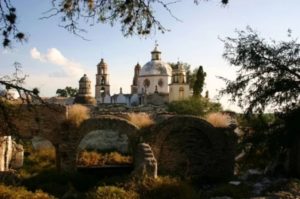
The importance of this enclosure is not only due to Martínez de Pocasangre. The sanctuary is also part of the Camino Real de Tierra Adentro or Ruta de la Plata, which was in operation between the 16th and 19th centuries. There are more than 60 sites distributed in several states of the country where silver and other minerals were transported. By the way, this route is also a World Heritage Site.
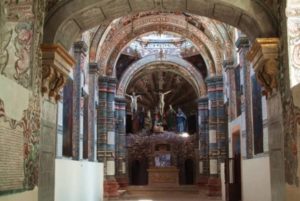
And, well, its relevance in the history of Mexico does not end here. The Sanctuary of Jesus Nazareno de Atotonilco is also one of the emblematic scenarios of the Route of Independence. The chronicles tell that Miguel Hidalgo y Costilla was the priest of this church for a time and from there he took an oil painting of the Virgin of Guadalupe to raise it as a banner of the Insurgent Army when he summoned the people to fight for Independence in the early morning of September 16, 1810.
However, INAH researcher Jacinto Barrera Bassols writes in his book, Pesquisa sobre un estandarte. Historia de una pieza de museo, that such banner did not exist, that it was rather an invention of a Michoacan archbishop to blame Hidalgo of “fautoría (using religious symbols for despicable purposes), one of the most punished ecclesiastical crimes”, according to a bulletin titled “Sucesos del estandarte de Hidalgo”, which can be consulted in the website of the National Institute of Anthropology and History (INAH).
In any case, this banner is preserved in the National Museum of History of the Chapultepec Forest.
The frescoes and architecture of the Sanctuary of Atotonilco
Between San Miguel de Allende and Dolores Hidalgo, in the state of Guanajuato, stands the Sanctuary of Nazareno in Atotonilco. It is said that it was surrounded by numerous springs.Its architecture is of a style called Mexican popular baroque. It preserves a simple facade but, in its interior, the visitor will be surprised to contemplate the frescoes of Antonio Martinez de Pocasangre. The master, who only painted during the day and studied perspective from his scaffolding, almost entirely covered walls, ceilings, columns, and vaults with profuse oil-painted images depicting “The Passion of Christ”. By the way, you have to wait a little longer, in case you want to visit it: the enclosure remains closed due to the pandemic, but we are already waiting for the next reopening date.
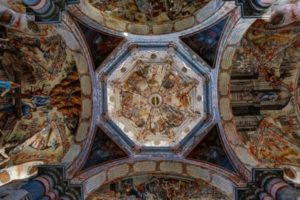
Experts say that his work is influenced by Flemish art but also has elements of indigenous art. There are about 2,500 square meters of surface covered with different techniques: “fresco, tempera, on canvas and amazingly, on silver” according to the tourism site Tierra Adentro San Miguel de Allende (tasma.com.mx); that is why it was baptized as the “Sistine Chapel of Latin America”.
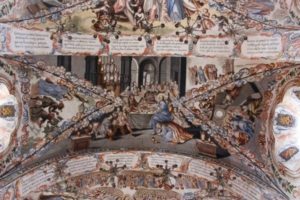
The sanctuary of Atotonilco is integrated by seven chapels that were built in several stages of its history. In addition to the chapels of the Holy Sepulcher and Calvary, the chapel of Bethlehem, dedicated to the Nativity; the chapel of the Cenacle, which belongs to the Virgin of Solitude; of the patron saint of San Miguel de Allende, the Virgin of Loreto; of the Rosary; and of the Purisima are preserved.
-

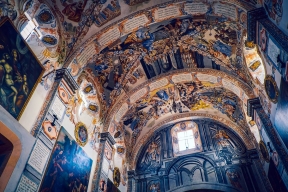
Leave a Reply